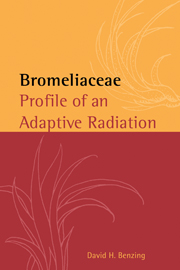Book contents
- Frontmatter
- Contents
- List of contributors
- Preface
- Acknowledgments
- Glossary
- Abbreviations
- Part one Brief overview
- Part two Basic structure, function, ecology and evolution
- 2 Vegetative structure
- 3 Reproductive structure
- 4 Carbon and water balance
- 5 Mineral nutrition
- 6 Reproduction and life history
- 7 Ecology
- 8 Relationships with fauna
- 9 History and evolution
- Part three Special topics
- Literature cited
- Name index
- Subject index
- Taxon index
5 - Mineral nutrition
from Part two - Basic structure, function, ecology and evolution
Published online by Cambridge University Press: 19 January 2010
- Frontmatter
- Contents
- List of contributors
- Preface
- Acknowledgments
- Glossary
- Abbreviations
- Part one Brief overview
- Part two Basic structure, function, ecology and evolution
- 2 Vegetative structure
- 3 Reproductive structure
- 4 Carbon and water balance
- 5 Mineral nutrition
- 6 Reproduction and life history
- 7 Ecology
- 8 Relationships with fauna
- 9 History and evolution
- Part three Special topics
- Literature cited
- Name index
- Subject index
- Taxon index
Summary
Arid climates and harsh substrates explain why certain Bromeliaceae figure so prominently in studies of drought-tolerance and CAM. Mineral nutrition has drawn sufficient attention to dispel misconceptions about how and from where the most specialized species secure essential ions, but certainly less interest than warranted by the presence of additional, even more exceptional mechanisms.
Contrary to appearances, none of the epiphytes invades host vasculature, nor does anchorage on bark or rock necessarily impose nutritional stress given the frequent access these plants have to fertile alternatives like decomposing litter, ant carton and prey (Figs. 5.1–5.3). Nitrogen-fixers and plantfeeding ants assist still other Bromeliaceae (Fig. 5.1). On balance, only a small fraction of the family, namely certain dry-growing Tillandsioideae (Fig. 1.3A,C), rely exclusively on precipitation and dry deposition for nutrition, hence deserve the loosely applied label ‘air plant’.
Leaf chemistry indicates that Bromeliaceae accumulate the expected six macronutrients and nine trace elements in the usual proportions (Table 5.1). Uptake also includes additional ions that support the same and other functions elsewhere. For example, Si, which in grasses helps deter grazers and stiffens the Equisetum stem, contributes to the light-reflecting granules in the epidermis of bromeliads native to sunny exposures (Fig. 4.23I). CAM types probably utilize Na like other similarly equipped xerophytes. Now and then, certain required elements concentrate far beyond metabolic needs; others accumulate for no recognized purpose, although they convey useful information about environments. Type Five Tillandsioideae exhibit sufficiently high affinities for certain technological' metals (e.g., Cr, V, Zn) and S to serve as inexpensive alternatives to the mechanical devices usually employed to monitor air quality (Tables 5.2, 5.3).
- Type
- Chapter
- Information
- BromeliaceaeProfile of an Adaptive Radiation, pp. 187 - 244Publisher: Cambridge University PressPrint publication year: 2000



